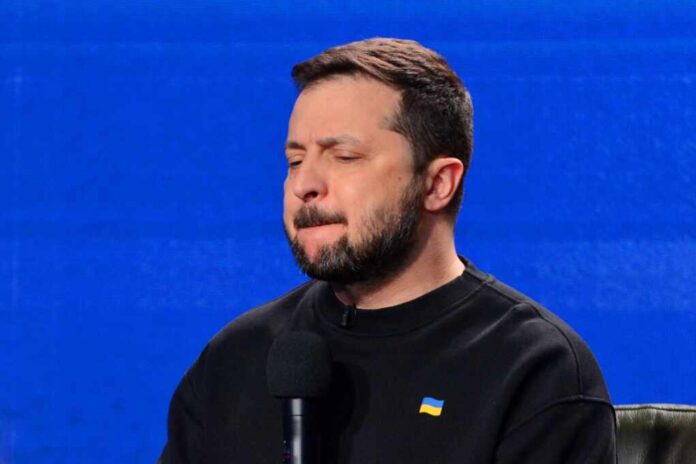
Germany takes the lead in a massive $24 billion military aid package for Ukraine as Western allies commit to supporting Kyiv through 2029 amid escalating tensions with Russia.
At a Glance
- Germany pledges $12.4 billion of the total $24 billion aid package for Ukraine’s defense
- Britain contributes $5.8 billion as part of the coalition of Western nations supporting Ukraine
- The funds are allocated until 2029 and focus on air defense, guided missiles, ammunition, and drones
- Ukrainian President Zelensky claims evidence shows 155 Chinese nationals are fighting for Russia
- U.S. President Trump’s cease-fire negotiation efforts have not yielded success
Germany Leads Western Coalition in Historic Military Aid
Germany has stepped forward as the primary contributor to a significant $24 billion military aid package for Ukraine, committing $12.4 billion in defense assistance through 2029. The announcement came during a crucial Ukraine Defense Contact Group meeting in Brussels, where allied nations reaffirmed their dedication to bolstering Ukraine’s military capabilities.
This substantial financial commitment represents one of the largest coordinated international efforts to support Ukraine since the conflict began, underscoring the strategic importance Western powers place on maintaining Ukraine’s ability to defend itself against Russian aggression.
The Ukraine Defense Contact Group, comprising 32 NATO members, 25 additional countries, and the European Union, continues to serve as the primary coalition coordinating military support for Kyiv. German Defense Minister Boris Pistorius emphasized the strategic necessity of providing Ukraine with the means to defend itself, particularly as the conflict enters what many officials describe as a critical phase.
The German contribution focuses specifically on strengthening Ukraine’s air defense systems, providing guided missiles, and ensuring a steady supply of ammunition—all crucial elements for Ukraine’s ongoing defense operations.
VERY BIG TOP NEWS TODAY⚡️🔥
🇺🇸 The US has announced a new $500 million aid package for Ukraine, – Austin
🇳🇴 In 2025, Norway will provide the largest military assistance in its history — over €2 billion to Ukraine.
🇬🇧 30,000 drones will be sent to Ukraine in 2025, £45 million… pic.twitter.com/xXdUzhJXAX
— MAKS 24 🇺🇦👀 (@Maks_NAFO_FELLA) January 9, 2025
Britain’s Substantial Contribution
Britain stands as the second-largest contributor to the aid package, pledging $5.8 billion toward Ukraine’s defense needs. British Defense Secretary John Healey highlighted the critical nature of the coming year in determining the trajectory of the Russia-Ukraine conflict.
The British portion of the aid package will focus heavily on radar systems and air defense capabilities, addressing the rapidly evolving nature of modern warfare. Britain’s commitment was initially announced earlier this year but has now been formally integrated into this coordinated multilateral effort.
“We need a militarily strong Ukraine,” said Boris Pistorius, emphasizing that this is the prerequisite for a “just and lasting peace.”
Norway has also joined the coalition, providing significant support for Ukraine’s drone capabilities. The increasing importance of unmanned aerial vehicles in modern combat was highlighted by Healey, who noted the devastating impact these weapons are having on the battlefield. According to British intelligence, drones are now responsible for a staggering majority of casualties in the conflict, fundamentally changing tactical considerations for both sides in the war.
Strategic Focus on Modern Warfare Technologies
The aid package reflects a keen understanding of the evolving nature of the conflict, with significant resources allocated to addressing the most pressing needs of Ukraine’s military. Beyond air defense systems and missiles, the funding will support the acquisition and deployment of drones, anti-tank mines, and crucial vehicle repair operations. This comprehensive approach aims to ensure Ukraine can maintain battlefield mobility while developing more sophisticated defensive capabilities against both ground and aerial threats.
“In our calculations, 70% to 80% of battlefield casualties are now caused and inflicted by drones,” revealed British Defense Secretary John Healey, highlighting the changing nature of modern warfare.
The announcement comes at a time when diplomatic efforts to resolve the conflict have shown little progress. U.S. President Donald Trump’s attempts to negotiate a cease-fire have not yielded meaningful results, and Ukrainian President Volodymyr Zelensky has raised concerns about international involvement in the conflict.
Zelensky recently claimed to have evidence showing 155 Chinese nationals fighting alongside Russian forces, potentially indicating a broader international dimension to the conflict that complicates both military and diplomatic calculations.
Long-Term Commitment Through 2029
Perhaps most significantly, the aid package demonstrates a long-term Western commitment to Ukraine’s security, with funding allocated through 2029. This extended timeframe sends a clear message about the coalition’s determination to ensure Ukraine maintains its defensive capabilities regardless of how long the conflict might persist. By providing this extended horizon of support, Western allies aim to counter any Russian calculations that might be based on outlasting international support for Ukraine or exploiting potential shifts in Western resolve.
The multilateral nature of this aid package, involving dozens of countries across Europe and beyond, reflects the continued solidarity among Western nations in responding to what many perceive as a fundamental challenge to European security and international order. As the conflict approaches its fourth year with no immediate end in sight, this substantial financial commitment signals that Ukraine’s allies remain determined to provide the necessary resources for the country to defend its sovereignty and territorial integrity against continued Russian military pressure.

























